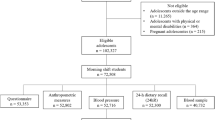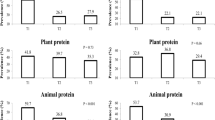Abstract
Objective: To examine the serum fatty acid composition, serum cholesterol levels, and dietary fat intake associated with body composition in primary school children of both urban and rural regions in Taiwan.
Design: Subjects were randomly stratified by region and primary school. The sample consisted of 870 children aged 10 and 11 y old. The sample was equally distributed between an urban region (Kaohsiung City) and a rural region (Yunlin County). The gender ratio of samples from each area was matched. Food record-assisted 24-h dietary recalls and serum lipid measurements were collected for each child, and associations between serum total cholesterol (TC) and fatty acids composition as well as between body mass index (BMI) and triceps skinfold (TSF) were evaluated for both urban and rural regions.
Results: Compared with students in the urban region, those in the rural region had significantly lower total fat intake, BMI, TSF, TC, and LDL cholesterol (LDL-C) and higher HDL-cholesterol (HDL-C) (P<0.05). Increased total fat (P<0.05) as a proportion of total energy was associated with increased TC and LDL-C. Lauric, myristic, and oleic acid levels in the serum of urban boys were significantly higher (P=0.0001, 0.0003, and 0.0398, respectively) than those of rural boys. In girls, the different fatty acid compositions affected TC concentrations, and palmitic and stearic acids of serum in the high-TC group were significantly lower (P=0.0179 and 0.0001, respectively) than those in the low-TC group.
Conclusions: Urban children had a dietary fat intake that both quantitatively and qualitatively differed from the traditional rural Chinese diet in Taiwan as reflected in rural children. Consumption of total fat was positively associated with BMI, TSF, TC, and LDL-C levels in Taiwanese children aged 10 and 11 y.
Sponsorship: This study was partly sponsored by a research grant from the Department of Health, Taiwan, ROC.
This is a preview of subscription content, access via your institution
Access options
Subscribe to this journal
Receive 12 print issues and online access
$259.00 per year
only $21.58 per issue
Buy this article
- Purchase on Springer Link
- Instant access to full article PDF
Prices may be subject to local taxes which are calculated during checkout
Similar content being viewed by others
References
Alaimo K, McDowell MA, Briefei RR, Bischof AM, Caughmon CR, Loria CM & Johnson CL (1994): Dietary Intake of Vitamins, Minerals and Fiber of Persons Ages 2 Months and Over in the United States: Third National Health and Nutrition Examination Survey, Phase 1. 1988–91. Hyattsville, MD: National Center for Health Statistics.
Angelico F, Hurtova M, Liuti A, Francioso S & Urbinati G (2000): Cholesterol levels in Italian school children: results of an opportunistic survey. Nutr. Metab. Cardiovasc. Dis. 10, 24–27.
Brox J, Bjørnstad E, Olaussen K, Østerud B, Almdahl S & Løchen ML (2002): Blood lipids, fatty acids, diet and lifestyle parameters in adolescents from a region in northern Norway with a high mortality from coronary heart disease. Eur. J. Clin. Nutr. 56, 694–700.
Carluccio MA, Massaro M, Bonfrate C, Siculella L, Maffia M, Nicolardi G, Distante A, Storelli C, De Caterina R (1999): Oleic acid inhibits endothelial activation: a direct vascular antiatherogenic mechanism of a nutritional component in the Mediterranean diet. Arterioscler. Thromb. Vasc. Biol. 19, 220–228.
Cheng HH, Shieh LH, Cheng CF & Shieh MJ (1995): Dietary characteristics and anthropometry in 10- and 11-year-old children in Taipei and Kaoshiung. J. Chin. Nutr. Soc. 20, 93–104.
Cheng HH, Wen YY, Liu YL, Shieh MS & Shieh MJ (1998): Dietary pattern, anthropometry and serum lipids of school children in Kaohsiung and Yunlin. Nutr. Sci. J. 23, 1–23.
Cheng HH, Yang SH, Chen C & Chiang MS (1999): Correlation of serum lipids, uric acid, and albumin among mother, offspring, and siblings in Taipei, Taiwan. Acta Paediatr Taiwan 40, 225–232.
Committee on Diet and Health (1989): Food and Nutrition Board, Diet and Health: Implications for Reducing Chronic Disease risk, pp 11–12. Washington, DC: National Academy Press.
Davda RK, Stepniakowski KT, Lu G, Ullian ME, Goodfriend TL & Egan BM (1995): Oleic acid inhibits endothelial nitric oxide synthase by a protein kinase C-independent mechanism. Hypertension 26, 764–770.
DISC Collaborative Research Group (1995): Efficacy and safety of lowering dietary intake of fat and cholesterol in children with elevated low-density lipoprotein cholesterol. The Dietary Intervention Study in Children (DISC). JAMA 273, 1429–1435.
Dwyer JT, Stone EJ, Yang M, Feldman H, Webber LS, Must A, Perry CL, Nader PR & Parcel GS (1998): Predictors of overweight and overfatness in a multiethnic pediatric population. Child and Adolescent Trial for Cardiovascular Health Collaborative Research Group. Am. J. Clin. Nutr. 67, 602–610.
Hargrove RL, Etherton TD, Pearson TA, Harrison EH & Kris-Etherton PM (2001): Low fat and high monounsaturated fat diets decrease human low density lipoprotein oxidative susceptibility in vitro. J. Nutr. 131, 1758–1763.
Hunter DJ, Rimm EB, Sacks FM, Stampfer MJ, Colditz GA, Litin LB, Willett WC (1992): Comparison of measures of fatty acid intake by subcutaneous fat aspirate, food frequency questionnaire, and diet records in a free-living population of US men. Am. J. Epidemiol. 135, 418–427.
Kipnis V, Freedman LS, Brown CC, Hartman A, Schatzkin A & Wacholder S (1993): Interpretation of energy adjustment models for nutritional epidemiology. Am. J. Epidemiol. 137, 1376–1380.
Kisanuki A, Asada Y, Sato Y, Marutsuka K, Takeda K & Sumiyoshi A (2000): Coronary atherosclerosis in youths in Kyushu Island, Japan: histological findings and stenosis. J. Atheroscler. Thromb. 6, 55–59.
Lee HY, Woo J, Chen ZY, Leung SF & Peng XH (2000): Serum fatty acid, lipid profile and dietary intake of Hong Kong Chinese omnivores and vegetarians. Eur. J. Clin. Nutr. 54, 768–773.
Lepage G & Ray CC (1986): Direct transesterification of all classes of lipids in a one-step reaction. J. Lipid Res. 27, 114–120.
Lytle LA (2000): In defense of a low-fat diet for healthy children. J. Am. Diet. Assoc. 100, 39–41.
Mamalakis G, Kafatos A, Manios Y, Kalogeropoulos N & Andrikopoulos N (2001): Adipose fat quality vs quantity: relationships with children's serum lipid levels. Prev. Med. 33, 525–535.
McGill HC, McMahan CA, Zieske AW, Tracy RE, Malcom GT, Herderick EE & Strong JP (2000): Association of coronary heart disease risk factors with microscopic qualities of coronary atherosclerosis in youth. Circulation 102, 374–379.
National Cholesterol Education Program (1999): Report of the Expert Panel on Blood Cholesterol Levels in Children and Adolescents, pp 91–732. Bethesda, MD: US Dept of Health and Human Services, Public Health Service, National Heart, Lung, and Blood Institute, National Institutes of Health.
National Institutes of Health (1998): Clinical guidelines on the identification, evaluation, and treatment of overweight and obesity in adults: the evidence report. Obes. Res. 6 (Suppl. 2), 51S–209S.
Nicklas TA, Dwyer J, Feldman HA, Luepker RV, Kelder SH & Nader PR (2002): Serum cholesterol levels in children are associated with dietary fat and fatty acid intake. J. Am. Diet. Assoc. 102, 511–517.
Olson RE (2000): Is it wise to restrict fat in the diets of children? J. Am. Diet. Assoc. 100, 28–32.
Rajaram S, Burke K, Connell B, Myint T & Sabate J (2001): A monounsaturated fatty acid-rich pecan-enriched diet favorably alters the serum lipid profile of healthy men and women. J. Nutr. 131, 2275–2279.
Sanders TAB (1999): Essential fatty acid requirements of vegetarians in pregnancy, lactation and infancy. Am. J. Clin. Nutr. 70 (Suppl), 555S–559S.
Simon JA, Hodgkins ML, Browner WS, Neuhaus JM, Bernert JT & Hulley SB (1995): Serum fatty acids and the risk of coronary heart disease. Am. J. Epidemiol. 142, 469–476.
Van Horn L (2000): Primary prevention of cardiovascular disease starts in childhood. J. Am. Diet. Assoc. 100, 41–42.
Yu-Poth S, Zhao G, Etherton T, Naglak M, Jonnalagadda S & Kris-Etherton PM . (1999): Effects of the National Cholesterol Education Program's step I and step II dietary intervention programs on cardiovascular disease risk factors: a meta-analysis. Am. J. Clin. Nutr. 69, 632–646.
Yu S, Derr J, Etherton TD & Kris-Etherton PM (1995): Plasma cholesterol-predictive equations demonstrate that stearic acid is neutral and monounsaturated fatty acids are hypocholesterolemic. Am. J. Clin. Nutr. 61, 1129–1139.
Author information
Authors and Affiliations
Corresponding author
Rights and permissions
About this article
Cite this article
Cheng, HH., Wen, YY. & Chen, C. Serum fatty acid composition in primary school children is associated with serum cholesterol levels and dietary fat intake. Eur J Clin Nutr 57, 1613–1620 (2003). https://doi.org/10.1038/sj.ejcn.1601732
Received:
Revised:
Accepted:
Published:
Issue Date:
DOI: https://doi.org/10.1038/sj.ejcn.1601732
Keywords
This article is cited by
-
Impact of diet on cardiometabolic health in children and adolescents
Nutrition Journal (2015)



